#Laravel Tutorial for Beginners
Explore tagged Tumblr posts
Text
Getting Started with Laravel: A Beginner’s Guide to Building Dynamic Websites
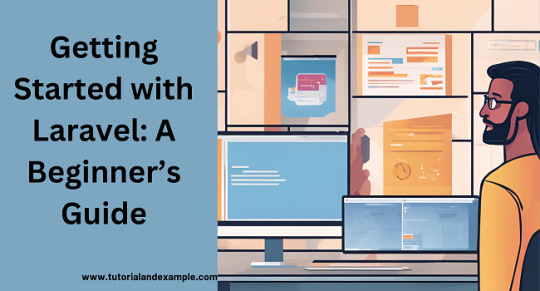
If you’re new to web development, Laravel is one of the best frameworks. It’s a PHP-based framework designed to make building modern web applications simple and efficient. In this Laravel Tutorial for Beginners, we’ll explore the basics of this powerful tool and how you can get started.
Laravel stands out because of its clean syntax and developer-friendly features. It comes with pre-built tools like routing, authentication, and database management, which save time and effort. Whether you’re building a small website or a large application, Laravel provides the flexibility to handle it all.
To begin, you’ll need to install Laravel. It requires PHP and Composer, as well as a dependency manager. Once installed, you can create a new Laravel project with a single command. Laravel’s structure is intuitive, making it easier for beginners to navigate through files and understand how things work.
One of the first things you’ll learn in Laravel is routing. This feature helps connect user requests to specific actions or pages in your application. Next, you’ll explore Blade, Laravel’s powerful templating engine, which allows you to create dynamic views with ease. Database management is also straightforward with Laravel’s Eloquent ORM, making it easy to interact with your database.
By learning Laravel, you’ll gain the skills to build modern, scalable web applications. Start exploring this fantastic framework and unlock your potential as a web developer.
For a detailed guide, visit Laravel Tutorial.
0 notes
Text
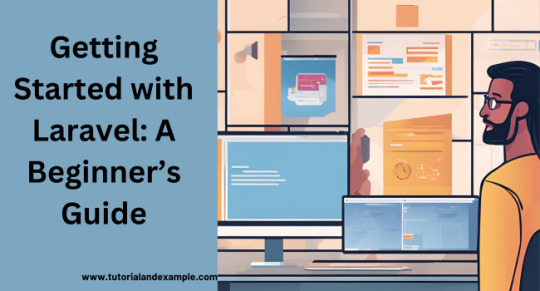
Looking to learn Laravel? Our beginner-friendly tutorial makes it easy! Master the basics, build powerful web applications, and gain confidence in coding. Perfect for anyone starting their web development journey with Laravel. Start learning today!
0 notes
Note
Do you have recommended resources for a total php noob?
Beginner-Friendly Tutorials and Courses
The official PHP manual It’s the best place to understand core functions, examples, and the most recent updates in PHP. To be used for consultations.
W3Schools PHP Tutorial: beginner-friendly. It’s easy to follow and gives you simple examples that you can run quickly.
PHP: The Right Way: good overview of best practices, coding standards, and modern PHP usage.
Laracasts is more known for Laravel (the framework) users, but they have a fantastic PHP basics series.
There’s a comprehensive YouTube tutorial from freeCodeCamp that covers the fundamentals of PHP.
Books
PHP & MySQL: Novice to Ninja by Kevin Yank
Modern PHP by Josh Lockhart
Join local PHP communities!
7 notes
·
View notes
Text

Comparing Laravel And WordPress: Which Platform Reigns Supreme For Your Projects? - Sohojware
Choosing the right platform for your web project can be a daunting task. Two popular options, Laravel and WordPress, cater to distinct needs and offer unique advantages. This in-depth comparison by Sohojware, a leading web development company, will help you decipher which platform reigns supreme for your specific project requirements.
Understanding Laravel
Laravel is a powerful, open-source PHP web framework designed for the rapid development of complex web applications. It enforces a clean and modular architecture, promoting code reusability and maintainability. Laravel offers a rich ecosystem of pre-built functionalities and tools, enabling developers to streamline the development process.
Here's what makes Laravel stand out:
MVC Architecture: Laravel adheres to the Model-View-Controller (MVC) architectural pattern, fostering a well-organized and scalable project structure.
Object-Oriented Programming: By leveraging object-oriented programming (OOP) principles, Laravel promotes code clarity and maintainability.
Built-in Features: Laravel boasts a plethora of built-in features like authentication, authorization, caching, routing, and more, expediting the development process.
Artisan CLI: Artisan, Laravel's powerful command-line interface (CLI), streamlines repetitive tasks like code generation, database migrations, and unit testing.
Security: Laravel prioritizes security by incorporating features like CSRF protection and secure password hashing, safeguarding your web applications.
However, Laravel's complexity might pose a challenge for beginners due to its steeper learning curve compared to WordPress.
Understanding WordPress
WordPress is a free and open-source content management system (CMS) dominating the web. It empowers users with a user-friendly interface and a vast library of plugins and themes, making it ideal for creating websites and blogs without extensive coding knowledge.
Here's why WordPress is a popular choice:
Ease of Use: WordPress boasts an intuitive interface, allowing users to create and manage content effortlessly, even with minimal technical expertise.
Flexibility: A vast repository of themes and plugins extends WordPress's functionality, enabling customization to suit diverse website needs.
SEO Friendliness: WordPress is inherently SEO-friendly, incorporating features that enhance your website's ranking.
Large Community: WordPress enjoys a massive and active community, providing abundant resources, tutorials, and support.
While user-friendly, WordPress might struggle to handle complex functionalities or highly customized web applications.
Choosing Between Laravel and WordPress
The optimal platform hinges on your project's specific requirements. Here's a breakdown to guide your decision:
Laravel is Ideal For:
Complex web applications require a high degree of customization.
Projects demanding powerful security features.
Applications with a large user base or intricate data structures.
Websites require a high level of performance and scalability.
WordPress is Ideal For:
Simple websites and blogs.
Projects with a primary focus on content management.
E-commerce stores with basic product management needs (using WooCommerce plugin).
Websites requiring frequent content updates by non-technical users.
Sohojware, a well-versed web development company in the USA, can assist you in making an informed decision. Our team of Laravel and WordPress experts will assess your project's needs and recommend the most suitable platform to ensure your web project's success.
In conclusion, both Laravel and WordPress are powerful platforms, each catering to distinct project needs. By understanding their strengths and limitations, you can make an informed decision that empowers your web project's success. Sohojware, a leading web development company in the USA, possesses the expertise to guide you through the selection process and deliver exceptional results, regardless of the platform you choose. Let's leverage our experience to bring your web vision to life.
FAQs about Laravel and WordPress Development by Sohojware
1. Which platform is more cost-effective, Laravel or WordPress?
While WordPress itself is free, ongoing maintenance and customization might require development expertise. Laravel projects typically involve developer costs, but these can be offset by the long-term benefits of a custom-built, scalable application. Sohojware can provide cost-effective solutions for both Laravel and WordPress development.
2. Does Sohojware offer support after project completion?
Sohojware offers comprehensive post-development support for both Laravel and WordPress projects. Our maintenance and support plans ensure your website's continued functionality, security, and performance.
3. Can I migrate my existing website from one platform to another?
Website migration is feasible, but the complexity depends on the website's size and architecture. Sohojware's experienced developers can assess the migration feasibility and execute the process seamlessly.
4. How can Sohojware help me with Laravel or WordPress development?
Sohojware offers a comprehensive range of Laravel and WordPress development services, encompassing custom development, theme and plugin creation, integration with third-party applications, and ongoing maintenance.
5. Where can I find more information about Sohojware's Laravel and WordPress development services?
You can find more information about Sohojware's Laravel and WordPress development services by visiting our website at https://sohojware.com/ or contacting our sales team directly. We'd happily discuss your project requirements and recommend the most suitable platform to achieve your goals.
3 notes
·
View notes
Text
Complete PHP Tutorial: Learn PHP from Scratch in 7 Days
Are you looking to learn backend web development and build dynamic websites with real functionality? You’re in the right place. Welcome to the Complete PHP Tutorial: Learn PHP from Scratch in 7 Days — a practical, beginner-friendly guide designed to help you master the fundamentals of PHP in just one week.
PHP, or Hypertext Preprocessor, is one of the most widely used server-side scripting languages on the web. It powers everything from small blogs to large-scale websites like Facebook and WordPress. Learning PHP opens up the door to back-end development, content management systems, and full-stack programming. Whether you're a complete beginner or have some experience with HTML/CSS, this tutorial is structured to help you learn PHP step by step with real-world examples.
Why Learn PHP?
Before diving into the tutorial, let’s understand why PHP is still relevant and worth learning in 2025:
Beginner-friendly: Easy syntax and wide support.
Open-source: Free to use with strong community support.
Cross-platform: Runs on Windows, macOS, Linux, and integrates with most servers.
Database integration: Works seamlessly with MySQL and other databases.
In-demand: Still heavily used in CMS platforms like WordPress, Joomla, and Drupal.
If you want to build contact forms, login systems, e-commerce platforms, or data-driven applications, PHP is a great place to start.
Day-by-Day Breakdown: Learn PHP from Scratch in 7 Days
Day 1: Introduction to PHP & Setup
Start by setting up your environment:
Install XAMPP or MAMP to create a local server.
Create your first .php file.
Learn how to embed PHP inside HTML.
Example:
<?php echo "Hello, PHP!"; ?>
What you’ll learn:
How PHP works on the server
Running PHP in your browser
Basic syntax and echo statement
Day 2: Variables, Data Types & Constants
Dive into PHP variables and data types:
$name = "John"; $age = 25; $is_student = true;
Key concepts:
Variable declaration and naming
Data types: String, Integer, Float, Boolean, Array
Constants and predefined variables ($_SERVER, $_GET, $_POST)
Day 3: Operators, Conditions & Control Flow
Learn how to make decisions in PHP:
if ($age > 18) { echo "You are an adult."; } else { echo "You are underage."; }
Topics covered:
Arithmetic, comparison, and logical operators
If-else, switch-case
Nesting conditions and best practices
Day 4: Loops and Arrays
Understand loops to perform repetitive tasks:
$fruits = ["Apple", "Banana", "Cherry"]; foreach ($fruits as $fruit) { echo $fruit. "<br>"; }
Learn about:
for, while, do...while, and foreach loops
Arrays: indexed, associative, and multidimensional
Array functions (count(), array_push(), etc.)
Day 5: Functions & Form Handling
Start writing reusable code and learn how to process user input from forms:
function greet($name) { return "Hello, $name!"; }
Skills you gain:
Defining and calling functions
Passing parameters and returning values
Handling HTML form data with $_POST and $_GET
Form validation and basic security tips
Day 6: Working with Files & Sessions
Build applications that remember users and work with files:
session_start(); $_SESSION["username"] = "admin";
Topics included:
File handling (fopen, fwrite, fread, etc.)
Reading and writing text files
Sessions and cookies
Login system basics using session variables
Day 7: PHP & MySQL – Database Connectivity
On the final day, you’ll connect PHP to a database and build a mini CRUD app:
$conn = new mysqli("localhost", "root", "", "mydatabase");
Learn how to:
Connect PHP to a MySQL database
Create and execute SQL queries
Insert, read, update, and delete (CRUD operations)
Display database data in HTML tables
Bonus Tips for Mastering PHP
Practice by building mini-projects (login form, guest book, blog)
Read official documentation at php.net
Use tools like phpMyAdmin to manage databases visually
Try MVC frameworks like Laravel or CodeIgniter once you're confident with core PHP
What You’ll Be Able to Build After This PHP Tutorial
After following this 7-day PHP tutorial, you’ll be able to:
Create dynamic web pages
Handle form submissions
Work with databases
Manage sessions and users
Understand the logic behind content management systems (CMS)
This gives you the foundation to become a full-stack developer, or even specialize in backend development using PHP and MySQL.
Final Thoughts
Learning PHP doesn’t have to be difficult or time-consuming. With the Complete PHP Tutorial: Learn PHP from Scratch in 7 Days, you’re taking a focused, structured path toward web development success. You’ll learn all the core concepts through clear explanations and hands-on examples that prepare you for real-world projects.
Whether you’re a student, freelancer, or aspiring developer, PHP remains a powerful and valuable skill to add to your web development toolkit.
So open up your code editor, start typing your first <?php ... ?> block, and begin your journey to building dynamic, powerful web applications — one day at a time.

0 notes
Text
Why PHP Still Rules in Web Development: Career Scope & Benefits
In today’s digital world, web development is one of the most in-demand skills. Whether you’re building a personal blog or a professional business website, coding languages play a big role. One such powerful and widely used language is PHP (Hypertext Preprocessor). Even after so many years, PHP still rules in web development, and many top companies continue to use it for their websites and web applications.
At Wavy Informatics, we believe in teaching technologies that offer real career growth. That’s why our PHP Training in Panchkula and complete Web Development Training are designed to make you job-ready in a short time.
Let’s understand why PHP continues to shine in the world of web development and how it can benefit your career.
What is PHP and Why is it Popular?
PHP is an open-source server-side scripting language. It is mainly used to create dynamic web pages that interact with databases. It has been around since 1995 and still powers more than 75% of websites on the internet, including Facebook, WordPress, and Wikipedia.
But the question is — why is PHP still so popular?
Here’s why:
Easy to learn: PHP has a simple syntax, making it easy for beginners to understand.
Large community: There is huge support online, with thousands of tutorials and forums.
Free & Open-source: No licensing cost means developers and companies can use it freely.
High compatibility: PHP works smoothly with all major databases and operating systems.
Career Scope in PHP Development
PHP is not just easy to learn, but also opens up many career opportunities.
Here are some roles you can target after PHP training:
PHP Developer
Full Stack Web Developer
Backend Developer
WordPress Developer
Laravel Developer
At Wavy Informatics, our PHP Training in Panchkula is perfect for those who want to enter the IT field with practical skills and real-world projects.
Benefits of Learning PHP for Your Career
If you’re still wondering whether to learn PHP or not, take a look at these major benefits:
1. High Demand in Small & Mid-Size Companies
Most startups and mid-level companies prefer PHP due to its low cost and flexibility. This creates a large number of job opportunities.
2. Freelancing & Remote Work
Many freelance websites like Upwork and Fiverr have hundreds of PHP-based projects. So, PHP also gives you the freedom to work from anywhere.
3. Quick Learning Curve
Compared to other languages like Java or Python, PHP can be learned quickly. You can start working on live projects in just a few weeks.
4. Strong Frameworks Support
Frameworks like Laravel, CodeIgniter, Symfony, etc., make PHP development faster and more secure.
5. Better Salary Packages
Good PHP developers with experience and framework knowledge can earn competitive salaries, especially in cities like Chandigarh, Mohali, and Panchkula.
Why Choose Wavy Informatics for PHP & Web Development Training?
We at Wavy Informatics focus on building careers, not just teaching. Our Web Development Training covers everything — HTML, CSS, JavaScript, MySQL, and of course, PHP with frameworks like Laravel.
Here’s what makes our training special:
100% practical classes
Live projects & assignments
Internship opportunity
Certificate + job placement support
Expert trainers from the industry
Our PHP Training in Panchkula is perfect for students, freshers, and working professionals looking to switch careers or upskill.
Frequently Asked Questions (FAQs)
Q1. Is PHP still worth learning in 2025?
Yes! PHP is still widely used across industries, especially for CMS like WordPress and custom web apps. It’s beginner-friendly and has great career scope.
Q2. How long does it take to learn PHP?
With dedicated effort, you can learn PHP basics in 30-45 days. Our course at Wavy Informatics includes hands-on practice, which helps you become job-ready faster.
Q3. What are the job opportunities after PHP training?
You can work as a PHP Developer, Backend Developer, WordPress Expert, or even start your freelance journey.
Q4. Do I need to know coding before joining this training?
No prior coding knowledge is needed. Our Web Development Training is designed for absolute beginners and covers all fundamentals step-by-step.
Q5. Will I get a certificate after training?
Yes. After successful completion of the training and project, you will receive a certificate from Wavy Informatics, which can help in job applications.
Final Thoughts
PHP has been around for decades and is still going strong. It offers great flexibility, large community support, and excellent career options. Whether you’re a student, a fresher, or someone looking to start a new journey in tech, PHP is a smart choice.
At Wavy Informatics, we are proud to provide the best PHP Training in Panchkula with real-time projects and industry-relevant content. Our Web Development Training prepares you for real-world challenges and sets you on the path to a successful tech career.
Ready to start your journey?Enroll in our PHP course today and unlock your web development career with Wavy Informatics.
Also Read:– Transform Your Career in Just 3 Months – Start Learning with Wavy Informatics
0 notes
Text
WebDev: What Every New Developer Should Know in 2025
In 2025, WebDev (web development) continues to evolve rapidly. From AI-generated code to low-code tools, staying updated is essential whether you're a beginner or a pro. But at its core, web development still relies on a strong understanding of HTML, CSS, JavaScript, and best practices in responsive design.
Modern WebDev is split into two main areas: frontend (user interface) and backend (server logic and databases). Mastering both gives you full-stack capabilities, which are in high demand.
Today’s web developers must also understand:
Version control (Git)
RESTful APIs
Accessibility (a11y)
Performance optimization
SEO for developers (clean code, metadata, page speed)
Frameworks like React, Next.js, and Astro are now dominating frontend projects. On the backend, Node.js, Django, and Laravel continue to power high-performance websites.
In 2025, AI-assisted coding tools like GitHub Copilot and ChatGPT are reshaping how developers write and debug code. But these tools work best when the developer understands the underlying principles.
For aspiring web developers, here's a roadmap:
Start with HTML, CSS, JS
Learn Git and GitHub
Pick a framework (React is a great start)
Build real-world projects (portfolio sites, blogs, eCommerce)
Keep learning through docs, tutorials, and community forums
The WebDev journey is challenging but rewarding. Whether you freelance, join a startup, or work for a tech giant, your skills will always be in demand. In short, the web is still where innovation happens—and you can be a builder.
0 notes
Text
DOKANS Nulled Script 3.9.2

Unlock E-commerce Potential with DOKANS Nulled Script Are you ready to transform your online business into a fully functional multitenant e-commerce platform without spending a fortune? DOKANS Nulled Script offers an unbeatable opportunity to create a scalable, efficient, and dynamic online marketplace—absolutely free. Whether you're a budding entrepreneur or an established developer, this powerful script provides the backbone for launching your own SaaS-based multi-vendor store in no time. What Is DOKANS Nulled Script? DOKANS Nulled Script is a premium multitenancy-based e-commerce platform designed specifically for creating software-as-a-service (SaaS) marketplaces. It allows users to build independent stores under a single ecosystem, offering flexibility, scalability, and seamless customization. With this nulled version, you can enjoy all the premium features without the hefty price tag, making it ideal for developers, resellers, and digital entrepreneurs. Technical Specifications Framework: Laravel (Backend) + Vue.js (Frontend) Database: MySQL/MariaDB Server Requirements: PHP 7.4 or higher, Apache/Nginx Multitenancy: Built-in SaaS capabilities Security: Advanced user authentication and permission systems Outstanding Features and Benefits When you download the DOKANS Nulled Script, you gain access to a powerhouse of tools tailored for modern e-commerce: 1. Multitenancy Support Let your users create and manage their own e-commerce stores under a unified platform. Each store operates independently with its own admin panel and branding. 2. Drag-and-Drop Page Builder Design custom pages effortlessly with an intuitive page builder. No coding knowledge required! 3. Flexible Subscription System Create revenue streams by offering tiered subscription plans to vendors. Manage upgrades, renewals, and custom packages with ease. 4. Secure and Optimized Enjoy enterprise-level security measures, regular updates, and optimized performance to handle growing traffic and vendors without lag. 5. Rich Admin Dashboard Access detailed analytics, financial reports, and vendor performance metrics from a beautifully designed admin panel. Practical Use Cases Launch a digital marketplace for fashion, electronics, or niche products Offer SaaS-based storefronts to clients and freelancers Create white-label solutions for local businesses and communities Monetize by charging store owners subscription fees or commissions How to Install DOKANS Nulled Script Download the latest version of DOKANS Nulled Script from our website. Extract the files to your server's root directory. Set up the database and import the SQL file provided. Edit the .env file with your database and app credentials. Run the necessary Laravel commands: composer install, php artisan migrate, and php artisan serve. Access the admin panel and begin configuring your multi-vendor platform. FAQs – Your Questions Answered Is DOKANS Nulled Script safe to use? Yes, the nulled script is thoroughly tested and secure for usage. However, always use a trusted source—like our website—for downloads to avoid hidden malware or vulnerabilities. Can I use this script for commercial purposes? Absolutely. With DOKANS Nulled Script, you can launch your commercial marketplace, monetize it with subscriptions, and offer clients fully functional e-commerce solutions. Do I need to know coding to use this? No coding skills are required for basic usage. The platform is beginner-friendly with intuitive interfaces. Advanced users can easily customize the backend thanks to its Laravel-Vue architecture. Where can I find compatible plugins or themes? You can enhance your site with additional tools like elementor nulled pro for intuitive design customization. Is there support or a user community? While nulled versions don’t offer official support, you can find active user communities and tutorials online. Plus, our platform is always here to help with guides and updates. Final Thoughts If
you're looking for a high-performance SaaS e-commerce script without the high cost, DOKANS Nulled Script is the answer. It's packed with features, easy to use, and completely free—giving you the ultimate edge in launching your own online marketplace today. Don't miss out on this game-changing opportunity to build and scale your digital empire. Want to enhance your site even further? Try out Slider Revolution NULLED and unlock limitless design possibilities!
0 notes
Text
How to Make Money with Programming: 9 Proven Ways to Earn from Your Coding Skills – Infographic
Programming isn’t just a skill, it’s a passport to countless income opportunities. Whether you’re a beginner or a seasoned developer, there are many ways to turn your coding knowledge into a reliable stream of income.
In this blog post infographic, we’ll explore nine effective ways to make money with programming, from starting a blog to developing games and selling online courses.

Download Infographic
1. Blogging
If you enjoy writing and have a passion for coding, blogging can be a fantastic way to earn money. Starting a programming blog allows you to share tutorials, code snippets, solutions to technical problems, or industry news. Over time, as your blog gains traffic, you can monetise it through:
Google AdSense
Affiliate Marketing (promote tools like GitHub Copilot, hosting providers, or IDEs)
Sponsored Posts
Email List Marketing
Choose a specific niche like Python automation, web development, or data science to attract a targeted audience. The more value you provide, the more loyal readers and passive income you can build.
2. Sell Books
Programmers who can write clearly and teach effectively often find success in self-publishing. Writing an eBook or paperback on a specific programming language, framework, or topic can generate steady income. You could publish:
Beginner guides (e.g. “Learn Python in 30 Days”)
Advanced problem-solving books
Interview preparation guides
You can sell books on platforms like Amazon Kindle Direct Publishing, Gumroad, or your own website. Add bonus material like source code or video content to increase value.
3. Web/App Development
One of the most straightforward and lucrative ways to make money with programming is by developing websites or mobile apps. Businesses everywhere need online presence and custom solutions. You can:
Build websites using WordPress, React, or Laravel
Develop mobile apps using Flutter or React Native
Offer eCommerce development (e.g. Shopify or WooCommerce)
You can sell your services to local businesses, startup founders, or online clients. Alternatively, create your own app or SaaS (Software as a service) and monetise it through subscriptions or ads.
4. YouTube Tutorials
YouTube is a powerful platform for programmers looking to build an audience and generate income. If you’re good at explaining concepts, start a programming channel with:
Coding tutorials (e.g. “Build a Todo App in JavaScript”)
Explainer videos (e.g. “What is an API?”)
Career advice and learning paths
You can earn money through YouTube ad revenue, channel memberships, sponsored videos, and affiliate links. Once your audience grows, you can also use your channel to promote your own products, like courses or software.
5. Freelancing
Freelancing offers flexibility and the ability to earn while working on a wide variety of projects. Platforms like:
Upwork
Freelancer
Fiverr
Toptal
…connect you with clients looking for developers. Whether it’s bug fixes, full-stack development, automation scripts, or WordPress setup, there’s always demand. To succeed, create a strong portfolio, offer competitive pricing, and deliver great results to gain repeat clients and referrals.
6. Games Development
If you’re passionate about gaming and have strong programming skills, consider game development. Platforms like Unity (C#) or Unreal Engine (C++) make it accessible to solo developers. You can:
Create indie games and publish them on Steam or itch.io
Build mobile games and monetise via ads or in-app purchases
Sell game assets, templates, or source code
Some developers also earn by creating tutorials, documentation, or toolkits that help other game developers.
7. Competitions
Coding competitions and hackathons are not just fun, they can be profitable too. Websites like:
HackerRank
Codeforces
TopCoder
Kaggle (for data science)
…often have prize money or sponsorship opportunities. Many companies also host hackathons and innovation challenges where winners receive cash, job offers, or equity. Even if you don’t win, competitions sharpen your skills and can improve your resume or portfolio.
8. Sell Software
Have a great idea for a tool that solves a problem? Package it as software and sell it! This could include:
SaaS tools (e.g. CRM for freelancers)
Developer tools (e.g. code snippet managers)
Desktop apps (e.g. productivity tools)
Browser extensions
You can monetise through one-time purchases, monthly subscriptions, or freemium models with paid upgrades. Promote your product through your blog, social media, or YouTube channel to build traction.
9. Sell Courses
Online learning is booming, and if you’re an expert in a topic, you can create and sell your own programming course. Platforms like:
Udemy
Teachable
Gumroad
Skillshare
…allow you to host and sell your courses to a global audience. Courses could focus on specific programming languages, frameworks, or skills like API development, data analysis, or building real-world apps.
High-quality video content, practical projects, and community support (e.g. Discord or Facebook group) will help you stand out and keep your students engaged.
Conclusion
Programming is one of the most versatile and valuable skills you can have in today’s economy. Whether you would like to work for yourself or build a side hustle, there are many ways to make money with coding, from sharing your knowledge through blogs or courses to building products and solutions for clients or the marketplace.
The key is to start with one path, stay consistent, and keep learning. As you grow in experience and confidence, you can diversify your income by combining multiple strategies. For example, many successful developers run blogs, YouTube channels, and sell software or courses all at once.
So pick your starting point, and begin turning your coding skills into real-world income!
0 notes
Video
youtube
Views & Nested View in Laravel | Part-8 | Laravel 11 Tutorials in Hindi
🚀 Master Laravel Views & Nested Views! 🚀
In this tutorial, we’ll dive deep into Laravel Views and Nested Views, helping you understand how to structure your Blade templates efficiently. Whether you’re a beginner or an experienced developer, this guide will make your Laravel development smoother!
🔹 Topics Covered: ✅ What are Views in Laravel? ✅ Creating and Using Blade Templates ✅ Passing Data to Views ✅ Understanding Nested Views & @include Directive ✅ Layouts & Extending Templates
0 notes
Text
How to Choose the Right Web Development Framework for Your Project
In today's digital landscape, a strong online presence is vital for businesses of all sizes. Whether you're a small business in Melbourne seeking a robust e-commerce site or a large enterprise looking for a bespoke solution, selecting the right web development framework is a critical first step. This decision can significantly impact your project's performance, scalability, and overall success. In this blog, we'll explore how to choose the proper web development framework, considering various factors to help you streamline the process.
Understanding Web Development Frameworks
Before we go into the selecting process, let's establish a web development framework. A web development framework is a software framework that serves as a foundation for creating web applications such as web services, APIs, and mobile apps. Frameworks usually have standard procedures for building and publishing online applications, allowing developers to include functionality with less repetitive code.
Factors to Consider When Choosing a Web Development Framework
1. Project Requirements and Goals
The first step in selecting a framework is clearly defining your project requirements and goals. Are you developing a simple website for a small business in Melbourne or a complex web application that manages large databases? Understanding the scope and complexity of your project can help you limit your possibilities.
For example, a lightweight framework like Flask might suffice if you're a small business and need a site for quick content updates. However, a more complex e-commerce platform might require a robust framework like Django or Ruby on Rails.
2. Performance and Scalability
Different frameworks offer varying levels of performance and scalability. If you anticipate your web application will grow in users or data, select a framework that can scale efficiently.
Node.js, for example, is known for its high performance and is suitable for real-time applications owing to its non-blocking architecture. This makes it a popular choice for applications requiring a quick response time, such as chat applications and live updates.
3. Community Support and Documentation
Regarding web development, the strength of the community surrounding a framework can't be overlooked. A strong community offers extensive documentation, forums, tutorials, and third-party tools that can aid in development.
Frameworks like Laravel (for PHP) have vibrant communities, ensuring you can find help or resources when needed. Choosing a framework with robust community support can save time and frustration during development.
4. Learning Curve
The learning curve associated with a framework can be a major consideration, depending on your team's existing skill set. For example, if your team is already conversant with JavaScript, then frameworks like React or Vue.js would be easier to adopt.
On the other hand, if your team is new to web development, opting for a more beginner-friendly framework like WordPress for small business web design Melbourne could provide a smoother entry.
5. Security Features
Security should always be a top priority when developing a web application. Review the security features offered by various frameworks.
Frameworks like Django come with built-in features that help protect against common security threats such as SQL injections and cross-site scripting. It's crucial to ensure that the web development framework you choose adheres to the latest security standards, especially if you're managing sensitive customer data.
6. Long-Term Viability
Choose a framework with a history of updates and sustained support to ensure long-term viability. Frameworks that receive consistent updates are more likely to remain relevant and secure against evolving threats.
Frameworks such as Angular and React have been well-maintained and updated regularly, making them reliable options for long-term projects.
7. Budget and Project Timeline
Finally, consider your budget and project timeline. Some frameworks may require more development time due to their complexity, which can increase costs. However, quality frameworks may allow for reduced development times due to streamlined processes and built-in functionalities.
If budget constraints are a concern, you might want to consider open-source frameworks like Laravel or Express.js, which are cost-effective while still providing powerful development tools.
Popular Web Development Frameworks
To help you further, here's a look at some popular frameworks you might consider:
Ruby on Rails: Known for its convention-over-configuration paradigm, it encourages rapid development and clean code.
- Django: A high-level Python framework that promotes rapid development and pragmatic design. It's particularly useful for projects requiring high security.
- React: This JavaScript library is perfect for building user interfaces and offers a performant approach to handling dynamic content.
- Angular: Google created Angular, a framework for developing mobile and desktop web apps with a broad feature set.
- Laravel: A PHP framework that simplifies common tasks and allows for elegant coding practices.
Choosing the ideal web development framework for your project can be tough, but by considering key factors such as project requirements, performance, community support, and budget, you can make an informed decision. If you're looking for a web development company in Melbourne, selecting one that understands your specific needs can assist elevate your project and deliver a tailored solution.
Whether you're engaging with a web design company Melbourne or a web development agency Melbourne, ensure they have experience with the frameworks relevant to your project. For small business web design in Melbourne, focus on frameworks that are not only user-friendly but also scalable to accommodate future growth.
In conclusion, take your time evaluating the options and making a choice that aligns with your business goals. A well-selected web development framework can be the bedrock of your project's success and lead your business to online triumph.
#seo services melbourne#web design melbourne#website design company melbourne#web development melbourne
0 notes
Text
Welcome to GetSampleCode, your go-to hub for web design and development sample codes. Explore a wealth of PHP code snippets and tutorials tailored for both beginners and seasoned developers. Dive into frameworks like CodeIgniter and Laravel to discover efficient solutions and best practices. Whether you're refining your skills or seeking inspiration, GetSampleCode provides the tools you need to elevate your projects. Start exploring today and harness the power of sample web development code at GetSampleCode.
0 notes
Text
Why Use Laravel to Develop Faster Web-Based Apps?
In the fast-evolving world of web development, choosing the right framework is crucial for building efficient, scalable, and high-performance applications. Laravel, a PHP framework, has emerged as a popular choice among developers for creating robust web-based apps quickly. Here’s why Laravel stands out and why you should consider it for your next web development project.

Elegant Syntax and Readability
Laravel is known for its elegant syntax that is easy to understand and write. This readability reduces the learning curve for new developers and enhances productivity for experienced ones. The clean and expressive syntax facilitates easier code maintenance and debugging, which is crucial for developing complex applications swiftly.
MVC Architecture
Laravel follows the Model-View-Controller (MVC) architectural pattern, which separates the business logic, presentation, and data layers. This separation simplifies the development process, making it easier to manage and scale applications. The MVC architecture also enhances performance and ensures that your web apps are both robust and maintainable.
Comprehensive Documentation
One of Laravel’s strong points is its comprehensive and well-structured documentation. Whether you’re a beginner or an advanced developer, Laravel’s documentation provides detailed guides, examples, and API references. This extensive documentation helps in speeding up the development process by providing clear instructions and solutions to common problems.
Built-in Authentication and Authorization
Laravel offers built-in tools for implementing authentication and authorization, saving developers significant time. The framework provides a simple and secure way to manage user authentication, including login, registration, password resets, and email verification. These out-of-the-box features help in quickly setting up secure user access in web applications.
Eloquent ORM
Laravel’s Eloquent ORM (Object-Relational Mapping) makes interacting with databases straightforward and intuitive. Eloquent provides a beautiful and easy-to-use ActiveRecord implementation for working with your database. This allows developers to perform database operations using simple, expressive syntax, reducing the time and effort needed to manage database interactions.
Artisan Command-Line Interface
Laravel comes with Artisan, a powerful command-line interface that provides a range of helpful commands for common tasks during development. From database migrations and seedings to creating boilerplate code, Artisan streamlines the development workflow, enabling developers to focus on building features rather than repetitive tasks.
Blade Templating Engine
Laravel’s Blade templating engine is simple yet powerful, allowing developers to create dynamic and reusable templates with ease. Blade’s lightweight syntax and template inheritance features help in building complex layouts quickly and efficiently. This templating engine enhances productivity by reducing the amount of boilerplate code and promoting code reuse.
Robust Ecosystem and Community Support
Laravel boasts a robust ecosystem with numerous packages and tools that extend its functionality. From Laravel Echo for real-time events to Laravel Passport for API authentication, the ecosystem offers solutions for various development needs. Additionally, Laravel has a vibrant community of developers who contribute to its continuous improvement, provide support, and share knowledge through forums, tutorials, and conferences.
Testing and Debugging Tools
Laravel places a strong emphasis on testing, with built-in support for PHPUnit and various testing methods. This focus on testing ensures that applications are reliable and bug-free. Laravel also offers debugging tools like Laravel Telescope, which provides insights into the application's requests, exceptions, and database queries, making it easier to identify and fix issues promptly.
Scalability and Performance Optimization
Laravel is designed with scalability in mind. Whether you’re building a small web app or a large enterprise solution, Laravel’s modular architecture and performance optimization features ensure that your application can handle increased traffic and complex operations efficiently. Laravel's caching, session management, and queueing system contribute to faster load times and improved application performance.
Conclusion
Laravel is a powerful and versatile framework that accelerates the development of web-based applications. Its elegant syntax, robust features, and supportive community make it an excellent choice for developers looking to build high-performance and scalable applications quickly. By leveraging Laravel’s capabilities, you can streamline your development process, reduce time-to-market, and deliver exceptional web-based apps that meet modern standards.
By using Laravel, you not only enhance your productivity but also ensure that your applications are secure, maintainable, and future-proof. So, if you’re planning to develop a web-based app, consider Laravel for a faster, efficient, and enjoyable development experience.
#web development#perception system#web portal development#software development#cloud consulting#web design#ecommerce development#it services#mobile app development#perception systemarketing
0 notes
Text
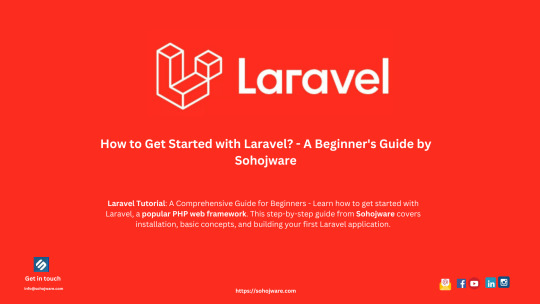
How To Get Started With Laravel? — A Beginner’s Guide By Sohojware
Laravel, a free, open-source PHP web framework, has become popular worldwide for web developers. Laravel streamlines development by providing a robust foundation for building modern web applications. This comprehensive guide from Sohojware, a leading US-based software development company, will equip you with the essential knowledge to embark on your Laravel development journey.
Why Choose Laravel?
There are many reasons why Laravel stands out in the world of web frameworks. Here are a few key benefits:
Elegant MVC Architecture: Laravel enforces the Model-View-Controller (MVC) design pattern, promoting clean code separation and maintainability. This structure makes your code easier to understand, test, and scale as your application grows.
Object-Oriented Approach: Built on top of PHP’s object-oriented capabilities, Laravel fosters code reusability and promotes a well-organized development workflow.
Built-in Features: Laravel comes packed with a plethora of pre-built functionalities, including authentication, authorization, routing, caching, database management, and more. This saves you time and effort by eliminating the need to develop these features from scratch.
Artisan CLI Tool: Laravel’s powerful command-line interface (CLI) tool, Artisan, simplifies common development tasks like generating models, migrations, controllers, and other boilerplate code. This speeds up development significantly.
Active Community and Ecosystem: Laravel boasts a large and active community of developers who contribute to its continuous improvement. This ensures access to extensive documentation, tutorials, and readily available packages for various functionalities.
Getting Started with Laravel
Now that you’re convinced about the advantages of Laravel, let’s delve into the steps to get you started:
1. Prerequisites:
Before diving into Laravel development, ensure you have the following tools installed on your system:
PHP (version 7.4 or later): Download and install the latest version of PHP from the official website (https://www.php.net/downloads/).
Composer: Composer is a dependency manager for PHP. Follow the installation instructions on the Composer website (https://getcomposer.org/).
2. Install Laravel:
There are two primary methods for installing Laravel:
Method 1: Using Composer:
Open your terminal and navigate to your desired project directory. Then, run the following command:
Bash

Replace “your-project-name” with your preferred application name. This command will create a new Laravel project directory with all its dependencies installed.
Method 2: Using Laravel Installer:
If you don’t have Composer installed, you can download the Laravel installer from the official website ([invalid URL removed]). Once downloaded, execute the following command in your terminal:
Bash

3. Set Up Database:
Laravel utilizes a database to store application data. You can choose from various database management systems like MySQL, PostgreSQL, or SQLite. Configure your database credentials in the .env file located at the root of your project directory.
4. Start the Development Server:
Laravel provides a built-in development server to run your application locally. Navigate to your project directory in the terminal and execute the following command to start the server:
Bash
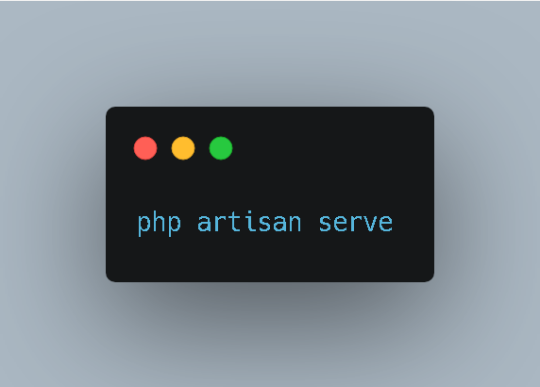
This will typically launch your application at http://localhost:8000 in your web browser.
5. Explore the Project Structure:
Laravel adheres to a well-defined directory structure, making locating and managing different application components easy. Take some time to familiarize yourself with the key directories like app, config, public, resources, and routes, each serving specific functionalities.
Building Your First Laravel Application
Now that you have a basic Laravel setup, let’s create a simple application to demonstrate its functionalities. We’ll build a basic blog system where users can view a list of posts.
1. Create a Model:
A model represents the data structure of your application. To create a model for posts, run the following Artisan command in your terminal:
Bash
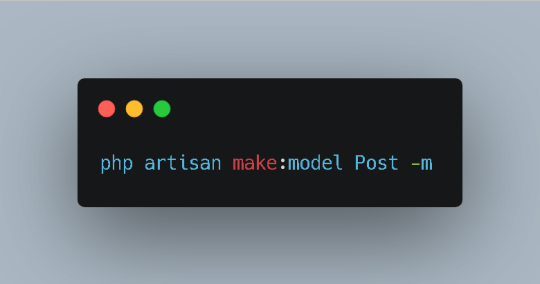
This command generates a Post.php file within the app directory. Modify this file to define the attributes associated with a post, such as title, content, and author.
2. Create a Migration:
A migration is a version control system for your database. It allows you to define changes to your database schema and easily roll them back if necessary. To create a migration for the Post model, run the following Artisan command:
Bash
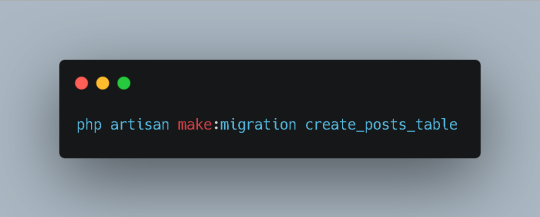
This will generate a new migration file within the database/migrations directory. Open the file and add the necessary columns to the up method. For example:
PhP
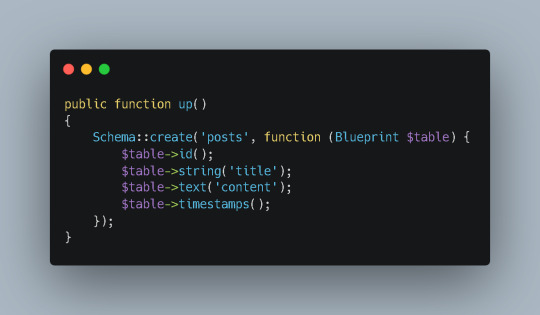
3. Run the Migration:
To apply the changes defined in the migration to your database, run the following command:
Bash
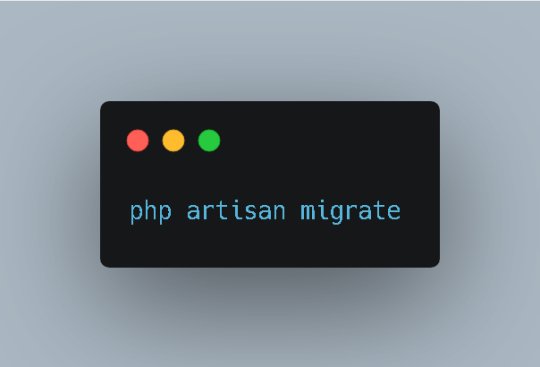
This will create the posts table in your database.
4. Create a Controller:
A controller handles user requests and interacts with your models. To create a controller for managing posts, run the following Artisan command:
Bash

This will generate a PostController.php file within the app/Http/Controllers directory. Inside the controller, define methods to handle different actions, such as displaying a list of posts, creating a new post, and editing or deleting existing posts.
5. Define Routes:
Routes map URLs to specific controller actions. To define routes for your blog application, open the routes/web.php file and add the following code:
Php

This route will map the root URL (http://localhost:8000) to the index method of the PostController class.
6. Create a View:
Views are responsible for rendering HTML content. To create a view for displaying the list of posts, run the following Artisan command:
Bash
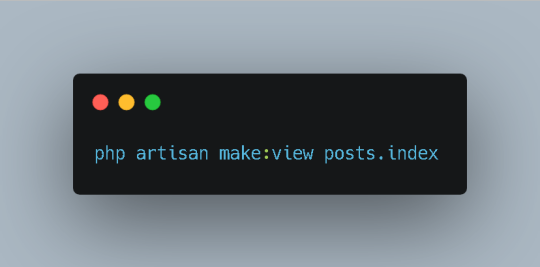
This will generate a posts/index.blade.php file within the resources/views directory. Inside the view, write the HTML code to display the list of posts.
7. Complete the Controller:
In the index method of the PostController, retrieve the list of posts from the database using the Post model and pass it to the view:
PhP

8. Test Your Application:
Access http://localhost:8000 in your web browser to see the list of posts displayed on the page.
Conclusion
This guide has provided you with a solid foundation for getting started with Laravel. By following these steps and exploring the framework’s rich features, you can efficiently build robust and scalable web applications. Remember, practice is key to mastering Laravel. Start experimenting with different features and building your own projects to enhance your skills.
FAQs
What is the difference between Laravel and CodeIgniter?
Laravel and CodeIgniter are both popular PHP frameworks, but they have distinct approaches and features. Laravel emphasizes convention over configuration and provides a more expressive syntax, while CodeIgniter offers a more lightweight and flexible structure. The choice between the two often depends on project requirements and developer preferences.
Can I use Laravel for large-scale applications?
Absolutely! Laravel is designed to handle complex and high-traffic applications. Its robust architecture, scalability features, and active community support make it a suitable choice for enterprise-level projects.
How does Laravel compare to other popular frameworks like Symfony and Yii?
Laravel, Symfony, and Yii are all powerful PHP frameworks with their own strengths and weaknesses. Laravel is known for its ease of use and expressive syntax, Symfony offers a more modular and customizable approach, and Yii emphasizes performance and efficiency. The best framework for your project depends on your specific needs and preferences.
Does Sohojware offer Laravel development services?
Yes, Sohojware provides professional Laravel development services. Our team of experienced developers can help you build custom Laravel applications tailored to your business requirements.
How can I learn Laravel more effectively?
The best way to learn Laravel is through hands-on practice and experimentation. Start by following tutorials and building small projects. As you gain confidence, gradually tackle more complex applications. Additionally, consider joining online communities and forums where you can connect with other Laravel developers and seek help when needed.
1 note
·
View note
Text
🔧 Build a Laravel Blog with Ease! 🔧
Ready to create a beautiful blog with Laravel and HTML? Our comprehensive guide walks you through each step, making it simple and efficient. Perfect for enhancing your web development skills and boosting your online presence! 🚀
Check out the full tutorial now! 🌐
0 notes
Text
Understanding Your Options: PHP vs. Python in Web Development
In the expansive realm of web development, the choice of programming language plays a pivotal role in determining the success and efficiency of your projects. Among the array of options available, PHP and Python emerge as prominent contenders, each bringing its own strengths and tailored applications. Whether you're a seasoned developer or new to the field, understanding the distinctions between PHP and Python is essential for making well-informed decisions that align with your project objectives and team dynamics.

The Debate: PHP vs. Python
The debate over PHP versus Python has captivated developers for years, driven not just by personal preferences but by practical considerations such as:
Project Requirements
The specific needs and scope of your project heavily influence whether PHP or Python is the optimal choice. PHP excels in web development, adept at creating dynamic websites and applications that integrate seamlessly with databases. Python, renowned for its versatility, extends beyond web development to encompass fields like scientific computing, data analysis, and artificial intelligence, offering a broader spectrum of applications.
Ease of Use
Both PHP and Python are celebrated for their user-friendly nature, albeit catering to different strengths. PHP's syntax is finely tuned for web development tasks, making it intuitive for developers familiar with web technologies. In contrast, Python's clear and readable syntax enhances code maintenance and fosters collaboration, making it especially appealing to beginners and teams prioritizing code clarity.
Community and Support
The robustness of a programming language's community profoundly influences its evolution and support ecosystem. PHP boasts a dedicated community focused on web development, ensuring comprehensive resources, tutorials, and documentation tailored to specific needs. Python, with its expansive and diverse community, serves a broad spectrum of professionals across various domains, driving continual growth and adaptation within the tech industry.
Performance and Scalability
Performance considerations are crucial, particularly for handling high-traffic web applications. PHP has significantly enhanced its performance with advancements like PHP 7, complemented by frameworks like Laravel and Symfony designed for scalability and efficiency. Python, although not traditionally noted for raw speed, compensates with frameworks such as Django and Flask, optimizing performance through efficient coding practices and robust third-party libraries.
PHP: Powering Web Development
PHP, originally an acronym for Hypertext Preprocessor, has been a stalwart in web development since its inception. Key reasons PHP remains a preferred choice include:
Specialization: Tailored specifically for web development, PHP excels in generating dynamic content and integrating seamlessly with databases. Frameworks like Laravel and Symfony provide developers with powerful tools and libraries for rapid application development.
Community and Resources: PHP benefits from a large, engaged community that contributes extensively to documentation and support resources. This wealth of knowledge ensures swift resolution of challenges, reinforcing PHP's reliability for building and maintaining web applications.
Scalability and Performance: PHP's evolution, particularly with PHP 7, has bolstered its scalability and performance capabilities. Its compatibility with leading web servers such as Apache and Nginx further enhances deployment flexibility and operational efficiency.

Python: Versatility and Beyond
Python's ascent in popularity is fueled by its adaptability and widespread applicability across diverse domains. Key reasons developers favor Python extend beyond traditional web development:
Readability and Simplicity: Python's clean syntax enhances readability and simplifies code maintenance, fostering collaboration and minimizing errors. This characteristic makes Python an excellent choice for projects prioritizing clarity and ease of comprehension.
Rich Ecosystem: Python boasts a vast ecosystem of libraries and frameworks catering to varied needs—from Django and Flask for web development to specialized tools like NumPy and Pandas for scientific computing and data analysis. The language's support extends to advanced fields such as machine learning with libraries like TensorFlow and PyTorch.
Community and Innovation: Python's expansive community drives continuous innovation and adaptation, ensuring the language remains at the forefront of technological advancements. This collaborative spirit underscores Python's relevance across industries and its resilience in evolving tech landscapes.
Choosing the Right Path
When deciding between PHP and Python for your web development projects, consider these critical factors:
Project Requirements: Assess whether your project necessitates specialized web development capabilities (PHP) or requires the flexibility to expand into diverse domains (Python).
Team Expertise: Evaluate your team's familiarity with each language and their proficiency in leveraging associated frameworks and libraries effectively.
Future Growth: Stay attuned to emerging trends and evolving web technologies to anticipate future project needs. Ensure your chosen language aligns with long-term goals and supports scalability as your project evolves.
Conclusion
In conclusion, PHP excels in specialized web development tasks with its robust frameworks and dedicated community. Meanwhile, Python offers versatility and scalability across a broad spectrum of applications, making it an ideal choice for projects requiring flexibility and future-proofing. By carefully weighing these considerations against your project's requirements and team capabilities, you can confidently navigate the dynamic landscape of web development, whether harnessing PHP's established strengths or exploring Python's expansive possibilities.
For those eager to deepen their Python expertise, consider exploring advanced courses or specialized training opportunities such as a Python course in Hyderabad, offering invaluable insights and practical skills to master this versatile language.
0 notes